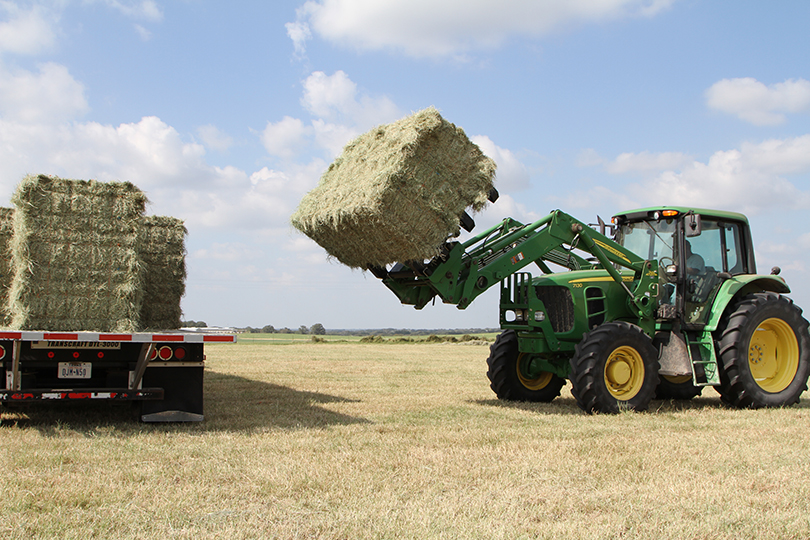USDA’s Farm Service Agency (FSA) reminds drought-impacted ranchers that they may be eligible for financial assistance through the Emergency Assistance for Livestock, Honey Bees, and Farm-Raised Fish Program (ELAP) to cover above normal expenses for hauling water or feed to livestock or hauling livestock to forage or grazing acres.
“Severe and widespread drought conditions are having a catastrophic impact on crops, grazing acres, livestock and agricultural operations statewide,” Kelly Adkins, state executive director for FSA in Texas, said. “Livestock producers should check in with FSA to request available ELAP assistance to help offset the above normal economic impacts of providing water, feed and forage to carry livestock through these extremely harsh weather conditions.”
For eligible producers in qualifying counties, ELAP provides financial assistance for:
- the transportation of water to livestock;
- the above normal cost of mileage for transporting feed to livestock; and
- the above normal cost of transporting livestock to forage/grazing acres.*
*Hauling livestock one-way, one haul per animal reimbursement and no payment for “empty miles.”
Eligible livestock include cattle, bison, goats and sheep, among others, that are maintained for commercial use and located in a county where qualifying drought conditions occur. A county must have had D2 severe drought intensity on the U.S. Drought Monitor for eight consecutive weeks during the normal grazing period, or D3 or D4 drought intensity at any time during the normal grazing period. Producers must have risk in both eligible livestock and eligible grazing land in an eligible county to qualify for ELAP assistance.
Transporting water
For ELAP water transportation assistance, ranchers must be transporting water to eligible livestock on eligible grazing land where adequate livestock watering systems or facilities were in place before the drought occurred and where water transportation is not normally required. ELAP covers costs associated with personal labor, equipment, hired labor and contracted water transportation fees. Cost of the water itself is not covered. The ELAP payment formula uses a national average price per gallon.
Transporting feed
ELAP provides financial assistance to livestock producers who incur above normal expenses for transporting feed to livestock during drought. The payment formula excludes the first 25 miles and any mileage over 1,000 miles. The reimbursement rate is 60% of the costs above what would normally have been incurred during the same time period in a normal (non-drought) year.
Transporting livestock
ELAP provides financial assistance to livestock producers who are hauling livestock to a new location for feed resources due to insufficient feed or grazing in drought-impacted areas. As with transporting feed, the payment formula for transporting livestock excludes the first 25 miles and any mileage over 1,000 miles. The reimbursement rate is 60% of the costs above what would normally have been incurred during the same time period in a normal (non-drought) year.
An online tool is now available to help ranchers document and estimate payments to cover feed and livestock transportation costs caused by drought. Download the tool and view the demonstration video.
Reporting losses
For calendar year 2022 forward, producers must submit a notice of loss to their local FSA office within 30 calendar days of when the loss is apparent. Producers should contact FSA as soon as the loss of water or feed resources are known.
For ELAP eligibility, documentation of expenses is critical. Producers should maintain records and receipts associated with the costs of transporting water to eligible livestock, the costs of transporting feed to eligible livestock, and the costs of transporting eligible livestock to forage or other grazing acres.
Additional drought assistance
ELAP assistance is also available to producers impacted by wildfire. Contact the local FSA office for more information on ELAP resources for wildfire losses. Beekeepers also can benefit from ELAP provisions and should contact their county FSA office within 15 calendar days of when a loss occurs or is apparent.
FSA is now accepting applications for the Livestock Forage Disaster Program (LFP) to provide financial assistance to eligible producers for 2022 grazing losses due to a qualifying drought or fire. The deadline to apply for 2022 LFP assistance is Jan. 30, 2023.
More than 200 Texas counties have met the drought severity levels that trigger LFP eligibility for the 2022 program year. For LFP, qualifying drought triggers are determined using the U.S. Drought Monitor A list of LFP eligible counties and grazing crops can be found on the FSA Texas webpage.
More information
Additional disaster assistance information can be found on farmers.gov, including the Farmers.gov Drought Webpage, Disaster Assistance Discovery Tool, Disaster-at-a-Glance fact sheet and Farm Loan Discovery Tool.
Correction: The drought assistance information from USDA FSA originally posted on July 20 incorrectly referenced assistance for purchased feed due to drought as a compensable expense through the Emergency Assistance for Livestock, Honey Bees and Farm-Raised Fish Program (ELAP). Feed purchase is not covered by ELAP for drought.


Does this include raising horses ?
Your FSA office can help determine if your equine operation qualifies.
Do they have a program for helping to drill wells for water,
how does tabulate the cost of transporting feed to stock. Grass loss with ongoing drought for cattle grazing, drilling well due to poor to little water due to ongoing drought for water to drink for cattle.
Is this only for large operations? What about us small ranchers with only a few head of cattle? They have to eat and drink as well.
Your FSA office can help determine if your operation qualifies.
Can you receive financial assistance in Guadalupe county to have a tank built for wildlife during drought as well as a water source for wildfires?
You can call your FSA office and visit with them about the options that are available.
Does this assistance include help buying hay for livestock!